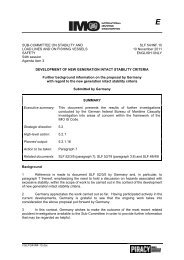Examination of the intact stability and the seakeeping behaviour
Examination of the intact stability and the seakeeping behaviour
Examination of the intact stability and the seakeeping behaviour
You also want an ePaper? Increase the reach of your titles
YUMPU automatically turns print PDFs into web optimized ePapers that Google loves.
6 Detailed examination<br />
this vessel by e.g. lling ballast water in tanks in low positions. When reducing <strong>the</strong> GM <strong>of</strong> <strong>the</strong><br />
ballast arrival loading condition, <strong>the</strong> transversal accelerations increase signicantly up to 10 m /s 2<br />
for a GM around 8.5 m. Then <strong>the</strong>y go down again to uncritical accelerations around 2 m /s 2 .<br />
Mentionable is <strong>the</strong> fact, that <strong>the</strong> accident <strong>of</strong> <strong>the</strong> Chicago Express occurred in a loading<br />
condition with <strong>the</strong> same GM = 8.54 m. (refer to BSU report [1]).<br />
Table 6.3: Stability data for <strong>the</strong> large vessel<br />
Ballast arrival loading<br />
Value Unit<br />
condition<br />
KM 25.64 [m]<br />
KG 13.24 [m]<br />
GM solid 12.40 [m]<br />
Light ship Value Unit<br />
vcg LSW 15.62 [m]<br />
16<br />
14<br />
Maximum transverse acceleration on <strong>the</strong> bridge [m/s 2 ]<br />
12<br />
10<br />
8<br />
6<br />
4<br />
2<br />
Ballast arrival loading condition<br />
0<br />
2 4 6 8 10 12 14 16<br />
GM solid [m]<br />
Accident situation 1 Accident situation 2 Accident situation 3<br />
Figure 6.3: Chicago Express in ballast arrival oating condition: Variation <strong>of</strong> GM solid<br />
6.1.4 Comparison <strong>of</strong> <strong>the</strong> simulation results<br />
In gure 6.4 <strong>the</strong> curves <strong>of</strong> <strong>the</strong> three vessels are compared for <strong>the</strong> accident situation 1. For <strong>the</strong><br />
o<strong>the</strong>r accident situations, <strong>the</strong> curve shape is comparable. It can be identied, that each vessel has<br />
a unique critical condition, where an exciting seaway in combination with <strong>the</strong> ship's hull form,<br />
<strong>the</strong> ship's trim <strong>and</strong> <strong>the</strong> GM value, result in very high transversal accelerations on <strong>the</strong> bridge.<br />
50

















